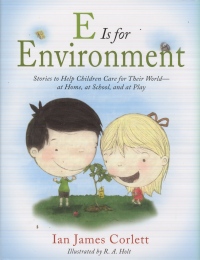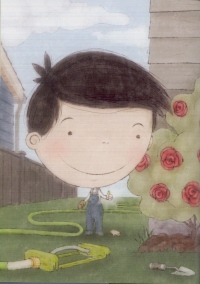| ________________
CM . . . . Volume XVII Number 37 . . . . May 27, 2011
excerpt:
In the introduction to E is for Environment, readers are introduced to Elliott and his sister, Lucy. They are inspired by a visit to their school from colleagues of their father's who are planning to run around North America to raise a million ‘bucks' for the planet. They introduce the children to the three R's – reduce, reuse and recycle. These colleagues, Matt and Stephanie, inspire the children with the Graham Nash song, "Teach your children well," by pointing out that the real words should be, "Kids, teach your teachers and your parents weller." (This may be a gratuitous point, but I thought I would relive my youth by reviewing the lyrics to this song. I always thought the song was also about children teaching their parents, the last verse starting with "Teach your parents well.")
Each episode is presented using a short vignette involving one of these issues followed by a ‘cliff hanger' question and answer. This is followed by more questions on the topic and a quote. Individuals quoted range from k.d. lang to Eeyore. Some of the individuals quoted may be more familiar to the young audience (Dr. Suess) than others (Benjamin Disraeli). Learning about those quoted would make for a great family research project. According to the literature supplied by the publisher, this book is designed to be used by families, with children 10 and younger, as a basis for discussion of environmental issues. I tried sharing this title with my nine-year-old, and she felt the text was condescending and objected to words such as tootsies for toes (p. 63), weenies for wieners (p. 65), and tooting for farting (p. 66). As a mother of two, I found the interaction between the siblings unbelievably congenial and supportive. My children (ages 12 and 9) were not interested in using this book as a springboard for discussion. Having said this, one must acknowledge Corlett's impressive CV in the children's entertainment field. He has been very successful at creating popular television shows. and perhaps he is more aware of what is of interest to children than I. E is for Environment might be of use to preschool and early elementary teachers as a springboard for discussion, but I don't think this would be appropriate for older children in the age range suggested by the publisher. Not recommended. Ruth McMahon is a professional librarian working in a middle school with daughters in middle and elementary school.
To comment
on this title or this review, send mail to cm@umanitoba.ca.
Copyright © the Manitoba Library Association. Reproduction for personal
use is permitted only if this copyright notice is maintained. Any
other reproduction is prohibited without permission.
NEXT REVIEW |
TABLE OF CONTENTS FOR THIS ISSUE
- May 27, 2011.
AUTHORS |
TITLES |
MEDIA REVIEWS |
PROFILES |
BACK ISSUES |
SEARCH |
CMARCHIVE |
HOME |

 This introduction sets up the 26 environmental lessons that the family explores. These lessons include: buying local, litterless lunches, eating vegetarian meals, and organic gardening. I don't think this volume reveals any groundbreaking new ideas on how to preserve our environment – bearing in mind that all of these ideas are worth hearing again. One episode that did surprise me was one recommending washing hands in cold water. The Centre for Disease Control website recommends hot water whenever possible.
This introduction sets up the 26 environmental lessons that the family explores. These lessons include: buying local, litterless lunches, eating vegetarian meals, and organic gardening. I don't think this volume reveals any groundbreaking new ideas on how to preserve our environment – bearing in mind that all of these ideas are worth hearing again. One episode that did surprise me was one recommending washing hands in cold water. The Centre for Disease Control website recommends hot water whenever possible.